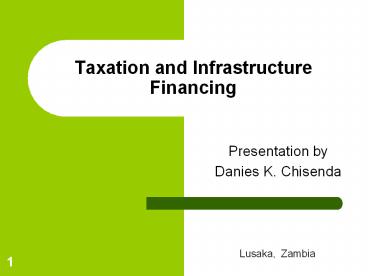Taxation and Infrastructure Financing - PowerPoint PPT Presentation
Title:
Taxation and Infrastructure Financing
Description:
Taxation and Infrastructure Financing Presentation by Danies K. Chisenda Lusaka, Zambia – PowerPoint PPT presentation
Number of Views:230
Avg rating:3.0/5.0
Title: Taxation and Infrastructure Financing
1
Taxation and Infrastructure Financing
- Presentation by
- Danies K. Chisenda
Lusaka, Zambia
2
Presentation Outline
- Introduction
- Financing for Development
- Taxation versus Infrastructure Development
- Some Challenges
- Conclusion
3
Introduction
- The Zambian Government has approved and launched
the Vision 2030 and the Fifth National
Development Plan (FNDP) 2006 - 2010 (Five year
Plan). - Emphasis in the FNDP is mainly on infrastructure
development due to its pivotal role in supporting
private sector investment (economic growth).
4
Introduction (Contd)
- In order to undertake this development, there is
need for resource mobilisation both domestically
and internationally - Many big infrastructure projects have largely
been financed by borrowing from multilateral or
international institutions.
5
Introduction (Contd)
- In Financing the Budget (Resource Mobilisation)
- Tax revenue
- Direct taxes - income tax, corporate tax,
withholding taxes, etc. - Indirect taxes - VAT, import taxes, excise
duties, etc. - Non-Tax Revenue
- Fees, fines, levies and others
- Grants from cooperating partners
- Budget Support and project Grants
6
Introduction (Contd)
- Domestic financing
- - Bank and non bank borrowing
- Foreign financing
- - Project and programme loans
7
Introduction (Contd)
- Spending of Resources (Expenditure)
- Recurrent Expenditure
- - Personal emoluments and operations of
Government. - Capital expenditure
- - Fixed Assets - Infrastructure (roads,
railways, dams, building, power stations,
water supply plants, etc. - - Movable Assets - motor vehicles, equipment,
etc.
8
Financing for Development
- This mainly involves fixed assets
(Infrastructure). In Zambia, financing for
infrastructure is by both domestic and foreign
resources - Domestic resources not adequate to finance major
infrastructural projects - Hence reliance on foreign borrowing and grants
9
Financing for Development (Contd)
- Some new ideas or innovations
- - Earmarking of some Domestic revenues for
infrastructure i.e. portion of excise duty
(fuel levy) for road maintenance, and excise
duty on electricity also earmarked for rural
electrification. - But resources not adequate.
- Other alternatives
- - Public Private Partnership (PPP)
- BOT (Build Operate Transfer)
- - Private sector investment
- - user charges
10
Taxation versus Infrastructure Development
- Some questions/Issues
- Should infrastructure projects be exempt from
taxation? - In practice, infrastructure projects financed by
co-operating partners are tax exempt. - Reasons advanced-
- - infrastructure projects will be too costly
- - mainly Government projects, not taxed.
11
Taxation versus Infrastructure Development
(contd)
- Should privately undertaken infrastructure
projects also be exempt from tax? - Tax Exemptions are bad because
- - distortionary
- - unfair
- - reduce revenues/ reduce tax base
12
Some Challenges
- Tax policy and administration must be tailored in
such way that they yield adequate resources to
Government but must be fair and effective in
order to promote economic growth. - Some problems in tax administration
- - Transfer pricing, tax sparing, smuggling,
- non-tax compliance have negative impact
- on total revenue,
13
Some Challenges (Contd)
- Tax exemptions have an effect of shrinking the
tax base i.e. less revenue to Government. - Taxing infrastructure projects financed by
multilateral institutions or cooperating partners
may face problems as they may not provide extra
resources and they will ask recipient country to
find extra money. - User charges as a means of financing may be
ineffective if services are rendered to the poor.
14
Some Challenges (Contd)
- Financing of infrastructure for developing
countries involves colossal amounts of money,
hence the multilateral institutions and
cooperating partners will continue to play an
important role. - The private sector involvement in infrastructure
financing is very much needed especially in
sectors that are commercially viable i.e. energy
sector.
15
Conclusion
- Financing access to basic utilities is a costly
venture requiring huge amount of resources and
the challenge for tax policy and administration
is to mobilise adequate financial resources. - The linkage between taxation and infrastructure
financing is not always direct for developing
countries because of the pooling of different
resources in one basket.
16
- I thank you for your attention.
- ___________































